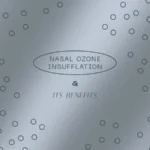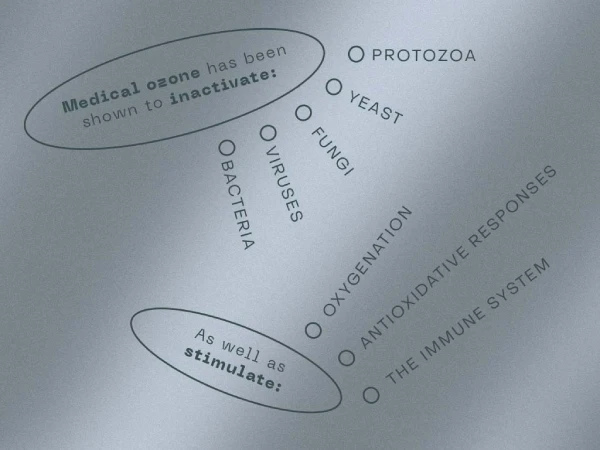Blog
Ozone Insufflation and its Benefits!

You may have heard the word “ozone” thrown around in the world of health and healing, especially for its effects on activating the immune system. Although it’s been gaining popularity in recent times, ozone therapy has actually been utilized and extensively studied for several decades. Let’s begin by defining what ozone is and how it’s used as a medical modality.
What is Ozone?
Ozone in the Atmosphere
Ozone itself is a gas that is made up of three oxygen molecules (O3). The oxygen that we breathe is made up of two oxygen molecules (O2). This difference in oxygen molecules makes ozone gas behave differently than oxygen gas. Ozone is a more unstable molecule than oxygen, which means it is more reactive, and therefore more able to induce specific (healing) effects when used appropriately.
Ozone gas is found naturally as part of the earth’s upper and lower atmosphere and serves to protect us humans from the harmful effects of UV radiation (protecting us from skin cancer and cataracts). Ozone gas that is found near the earth’s surface (in smog) is mostly a result of pollution from human activities and can be dangerous, as its inhalation is known to be toxic to the lungs and respiratory tract.
Medical Grade Ozone Therapy
Ozone gas can also be man-made for medical purposes; medical grade ozone is what is used in the clinical setting. Ozone therapy is the process of administering ozone gas into the body for therapeutic benefit.
Medical ozone has been shown to inactivate:
- Bacteria
- Viruses
- Fungi
- Yeast
- Protozoa
As well as stimulate:
- Oxygenation
- Antioxidative responses
- The immune system
For these reasons, ozone therapy has been used as a disinfectant and a means to treat various infections, wounds, and conditions of low blood flow (and thus oxygen), inflammation, and impaired immunity. Ozone therapy has been touted to promote total body wellness because of its ability to detoxify and oxygenate the blood (thereby energizing the entire body).
Ozone IV vs Ozone Insufflation
It’s important to keep in mind that there are various types of ozone therapy which differ in their route of administration. The two common types of this therapy include IV (intravenous) ozone and ozone insufflation.
IV ozone therapy involves administering ozone directly into the bloodstream, which promotes systemic (or body-wide) effects. Ozone insufflations involve administering ozone directly into a body cavity, causing a more localized effect (sort of like an internal rinse). The type used will depend on the condition(s) being treated or managed.
In this blog we will focus on nasal ozone insufflation, which means administering ozone through the nasal cavities. Though it does not pertain to this discussion, know that ozone insufflation can be administered through other body sites including the mouth, ear, rectum, bladder, and vagina. Remember, ozone gas is never inhaled in the medical setting. Nasal insufflation provides a safe approach because it is a method of delivering a small yet therapeutic amount of ozonated substance through the nasal passages.
How is Ozone Insufflation Administered?
So, how does this process work? Well, it’s a fairly fast and easy procedure: ozone is filtered through a specialized oil, creating an ozonated oil, which is then pushed through the nostrils with the use of a syringe (without a needle). The ozonated oil ultimately reaches the sinuses and delivers its therapeutic actions. This may cause an initial cleansing out of mucus drainage.
This therapy is most indicated for individuals with chronic sinusitis and sinus inflammation as a result of allergies or infections (such as the common cold).
Ozone insufflation may help to relieve the symptoms of sinusitis including:
- Facial pain/pressure
- Headache
- Nasal inflammation/congestion
- Postnasal drainage
- Runny nose
- Reduced sense of smell and taste
- Ear pain
- Cough
- Sore throat
- Fatigue
- Fever
It can also help treat:
- Asthma
- Bronchitis
- Other upper respiratory infections
Nasal ozone insufflation can be used to treat both acute and chronic conditions – either on its own or in conjunction with other therapies. It is a wonderful way to simultaneously address the root cause and provide symptomatic relief.
This therapy has a cumulative effect, so it is often performed for several days in a row or multiple times each week until symptoms improve. A typical treatment series would last a total of 4-8 weeks, depending on the severity of infection.
Overall, this therapy is a non-invasive, natural, safe, and effective treatment option. LIVV is proud to offer nasal ozone insufflation! This procedure does require a consultation with one of our amazing naturopathic doctors in addition to bloodwork. Call today to book your appointment with us!
Written by Jordan Valdez, RDN
References
Elvis AM, Ekta JS. Ozone therapy: A clinical review. J Nat Sci Biol Med. 2011;2(1):66-70. doi:10.4103/0976-9668.82319
https://www.epa.gov/ozone-pollution-and-your-patients-health/what-ozone
https://csl.noaa.gov/assessments/ozone/2010/twentyquestions/Q1.pdf
https://fernandobernall.com/benefits-of-ozone-therapy/#insufflation


